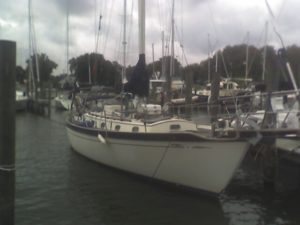The Early Years 2007-2014
I had search high and low for “my boat”, from Delaware to North Carolina and worldwide through the Internet. By the end of August 2007, it was getting a little old. I had put in several offers, but they all fell through for one reason or another.
I traveled as far south as Oriental, North Carolina in late August. When I saw her in Deaton’s Boatyard in Oriental in early September, it was almost love at first sight. She was the right size, 40 feet—the size I know I could sail singlehandedly, with a few modifications. She had a deep, full keel that would provide a comfortable ride. She was built to take to blue water, so there was a strong safety factor. Her interior was beautiful. And she had air conditioning, a microwave, a full galley, a full head with shower and host of other attributes.
The engine had 300 hours, almost new and the asking price($125k) seemed within range if I could get a decent discount.
It became obvious that the current owners had lost interest. The bottom had not been cleaned in years and was encrusted with crustaceans and other marine life. It was a hot day, and I have to admit, she smelled bad, really bad. The bottom also had an unknown number of blisters, areas where water had entered the first layer of the boat (the gelcoat), reacted with residue from the manufacturing process, and expanded, breaking the bond between the gelcoat and the fiberglass itself. The varnish had long ago failed and was peeling where it had not just disappeared. The electronics package was very dated (mid-nineties).
I still have the notes I took that day. Here are my comments:
“Beautiful interior, hatches plexiglass, generator, dinghy, small cockpit, main not led aft, manual windlass. Too big?
I engaged Rich Kahn as a broker. Rich is a Baba owner and knows more about Baba’s than anyone I know with the exception of the designer, Bob Perry. We made an offer of about 90k on September 4th and settled on 100k as a purchase price. Rich recommended Tarn Kelsey as a surveyor and we arranged a survey date. On September 12, 2007, Rich, Tarn, a friend of mine, and I travelled to Oriental for the survey. Tarn found the boat to be in good condition with only a few “required repairs”. Tarn confirmed the blistering, but indicated it was only cosmetic.
Since the boat had been sitting for so long, there were a number of operational issues before we could take ownership. The water pump for refrigerator did not pump water (plugged with a wasp nest) and the generator did not work (fixed by the yard).
We were also concerned about the integrity of the fuel tanks and asked them to be pressure tested at our expense and then refilled with fresh diesel. The yard could not get the tanks to hold pressure, but there were no discernable leaks.
On September 25th, 2007, I became the owner of the Baba 40, once known as “Jolly Roger, now known as “Sophia”.
I did not like the homemade dinghy that came with the boat, so I bought a used dinghy and motor for our trip north.
My friend offered to help me to sail her back to Herrington. On October 2, 2007 we sailed from out of Deaton’s on a great adventure.
We sailed out of a very narrow, shallow creek into the Neuse River, raised sailed and sailed through Pamlico Sound, dropping anchor at Bellhaven. After a brief visit to the town of Bellhaven, we proceeded through the Pamlico-Alligator Canal, doing the last five miles in the dark (there nothing so dark as a canal, cut through the swamps, on a moonless night). Coming out of the Canal, we had a set of turns that were a bit confusing in the dark and with our handheld GPS and we “bumped” aground at least once. We anchored as soon as we got into the Alligator River and turned our exhausted bodies into bed.
We continued up the Alligator, crossed the Sound and into the North River, anchoring for the night south of Coinjock. We stopped at Coinjock for the next day, did some laundry, filled the water tanks. The next day was the long trip to Great Bridge, south of Norfolk. We travelled on through the Elizabeth River and on to Deltaville and Fishing Bay.
The next days the winds were out of the Northwest and we tried to sail close hauled. The winds got pretty stiff, so we decided to furl the genoa. Pop! The genoa furling line broke, leaving the genoa out and no way to retrieve it. My ignorance of roller furlers began to show. I tried to bring down the genoa but failed (ultimately I figured out there was too much wind and pressure on the sail, but that was much later). We hauled down the main and tried to sail with genoa only. Meanwhile, we started smelling burnt rubber when we used the engine and decided not to use anymore. Now it gets dark, and we are trying to tack without the main in a 25 knot head wind. We have an inner forestay, that catches the genoa on every tack, which means I have to go out on deck and walk the genoa through the slot between the inner and outer forestays and then run back to bring in the sheet. Many times the sheets would get tangled and we would need to take some time to straighten them out. Each tack we lost whatever distance north we had made on that leg. We managed to make a mile after 4 hours of back and forth at the narrow point in the bay. Morning finally came, the winds slacken, and we got the genoa down, started the engine and proceeded north. In hindsight, I should have sailed back to Deltaville. It would have been an easy downwind sail, we knew the anchorage well, and we would have saved ourselves a lot of wear and tear, not to mention we tore the heck out of the genoa during all the tacking and resulting luffing.
We motored on to Herrington Harbour Marina and into our slip on E dock, Sophia’s home for the next 8 years.
Winter was approaching and the genoa was in need of repair, so there was not much sailing that year. I winterized the boat early and had her pulled out and stored “on the hard”. The task of fixing those blisters began immediately. I had gotten and rough estimate of the cost of having the yard do the work ($20,000) but there was no money left for such work. So, I got into doing it myself. I sanded off the critters that remained on the hull, and started identifying blisters that need to be drilled out. The more I sanded, the more blisters I found. I worked Thanksgiving Day and Christmas Day. I “tented” the hull with plastic so I could work in the cold and to protect other boats.
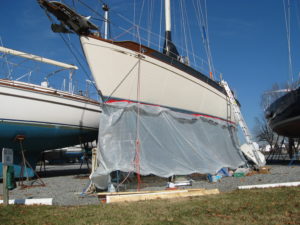
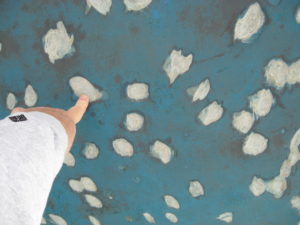
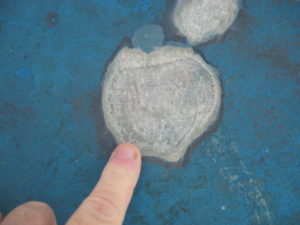
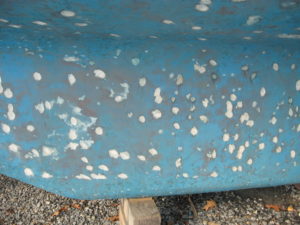
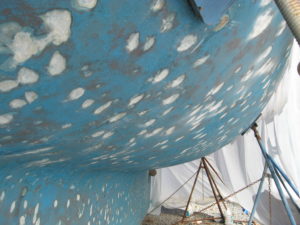
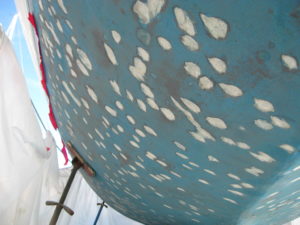
By April, I had drilled out close to 2000 blisters. Then I began to apply layers of epoxy, using West System including stiffener that help prevent sagging. One, two, three, four, sometimes five or six layers of epoxy, sanding each layer so that it was even with the hull. On and on the work went, but sometime in June, we were ready for launch.
I still have the work list from February 2008. Everrything on that list eventually got done, but it did not happen in 2008 (or 2009 or 2010).
The one thing that did get done early is the quick release, re-moveable inner forestay. When lots of tacking of the genoa is expected, the forestay can be pulled aft and to the side so that the genoa will move easily side by side.
(In 2016, Atlantic Spars and Rigging was doing some work and they had brought on a guy who was really “retired”. It was the same guy who did the work on the inner forestay. Small world. I still have the receipt for that first work.)
In 2008, I concentrated on the woodwork. We took down all the old varnish to bare wood, put five coats of “Cetol” artificial varnish. In the spring of 2009, I did all the rub rails and the cap rail while the boat was on the hard. We also varnished all the hatches, both inside and out. Nicholas Bazarian often helped me with the varnishing work and I remain immensely grateful for his help.
Also in 2008, I replace much of the canvas, replacing the dodger and bimini (and raising the height by 6 inches so I could stand on the cockpit seat without bending over). I also began a long relationship with “Captain Canvas”, George Whitehead, one of the most careful and meticulous craftsman I have ever met. Every winter I would give George work for delivery in the spring. The last being the winter of 2015-2016. George passed away in September 2016. He will be missed on Sophia everytime we zip up a window or put the dinghy cover on.
In 2009, there was a lot more sailing going on. I solo sailed down the Bay to visit my nephew, my brother and my sister (both of whom were visiting). We all went for a day sail and had a great time.
I also took the “office” out for a sail, which was another great day.
I still have my “to do” list from back then written in February 2008. It included such things as varnishing, running the lines to the cockpit and a new chartplotter. Everthing eventually got done, but it wasn’t completed as planned in 2010….it took another 6 years.
When it came time to winterize in December 2009, I got some unexpected help (see We find a mate). Not much works was done in the winter of 2009-2010.
As a result of the grounding in Rock Hall, we bought a new chartplotter (Garmin 400)
Winter of 2010-2011, I overhauled the head (toilet) sysem, replacing the toilet, the Lectrasan waste treatment system and all the piping. It was a long winter, working much of the time upside down in the forward bunk (location of Lectrasan) and the rest of the time squeezed into some tight spaces in the head trying to run pipes that did not want to bend in the cold.
In 2011, I bought a new genoa from an Australian/Thailand company…Rolly Tasker sails.
In 2013, I had Atlantic Spars and Rigging conduct a complete rigging survey. For the most part, they did not find much, but did suggest replacing the roller furler.
IN 2013, we installed a AIREX wind generator on a Kato mast with a dinghy moto lift. We also installed the XM/Sirius Satellite Radio.
In January 2014, we replaced all the lifelines.
In March 2014, we replaced the house (service) batteries with 1 8D AGM and 3 Group 31 XT batteries for a total of 630 amp-hours.
During the winter of 2014-2015, I ran the main halyard, the main reefing lines, and the topping lift to the cockpit, so I can handle all mainsail actions from the cockpit. I aslo installed an Garmin AIS-600 Automated Identification System transponder.
We also bought a new Garmin 741 chartplotter.
In March 2015, we replace the genoa roller furler with a Schaefer 2100 furler.
(Note for the sailing purists: In 2004, the original chainplates and rigging was replaced by Deaton Boatyard)
For each spring commissioning, we did the following work:
· Sand and paint the bottom
· Replace the zincs
· Two coats of wax on the sides
· Refresh Cetol with two coats gloss on the rub rail, the cap rail, and scroll work
· Replace bungs on the teak deck and recaulk as necessary
This would take approximately three weeks of constant work.
Before I end this section, I must pau homage to my first two boats. My first was a Kells 23 which I bought as a graduation gift for myself in 1996 for $1000 dollars. I worked hard a refinishing it, making a mess in Quantico Marina. I learned to sail on that boat, mostly alone. But it had no galley, not much of a head, and no lifelines.
In 2001, I bought a Catalina 25 for $11,000. Inshallah was her name and she was great little boat. I moved her from Quantico to the Chesapeake Bay in the April 2002. It was a great 4 day trip, aided by some young folks that were kind enough to help. I stored the Kells at Fort Belvoir, but ignored her for too long. Her scuppers filled with leaves and the hull filled with water, until she was waterlogged and the hull became soft. I learned that two boats is one boat too many.
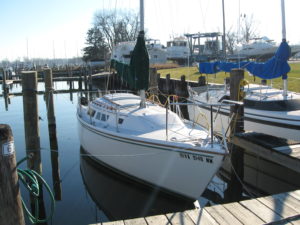
I sailed the Catalina up and down the Chesapeake Bay from 2002 to 2007. It was good sailing, but too much like camping out for a 50+ year old guy, with a alcohol stove that would send a flame two feet high and limited sleeping space. Because of some good fortune and the IBM’s generosity, I was able to buy the “big boat” in 2007 and went out looking for that boat. I sadly sold Inshallah to someone on the South River and I hope she was taken care of. But like an old girlfriend, I still miss her and look for her unique lines in every Catalina 25 I see.
By 2015, everything that was going to get done was done, I had sailed up and down the Chesapeake Bay so often I could do it asleep, and, so, it was time to go cruising.

